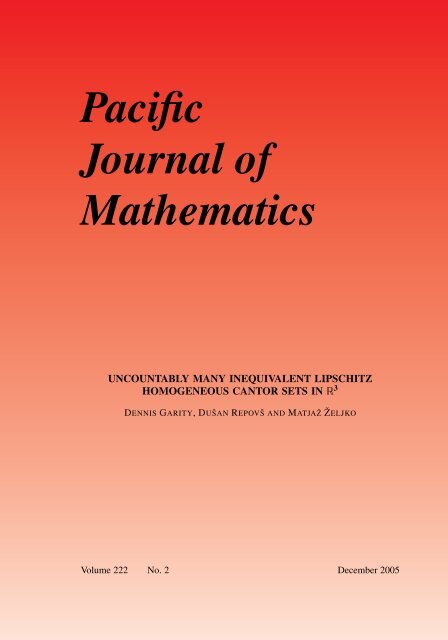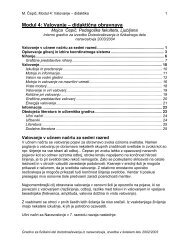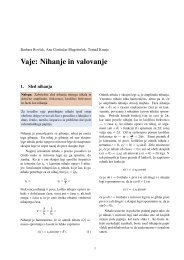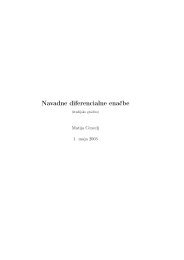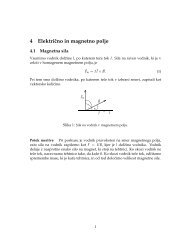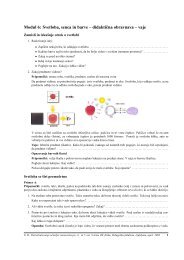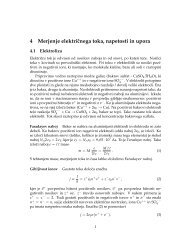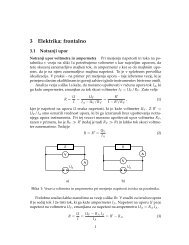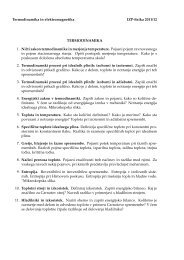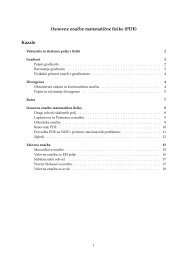Uncountably many inequivalent Lipschitz homogeneous ... - dMFA
Uncountably many inequivalent Lipschitz homogeneous ... - dMFA
Uncountably many inequivalent Lipschitz homogeneous ... - dMFA
Create successful ePaper yourself
Turn your PDF publications into a flip-book with our unique Google optimized e-Paper software.
Pacific<br />
Journal of<br />
Mathematics<br />
UNCOUNTABLY MANY INEQUIVALENT LIPSCHITZ<br />
HOMOGENEOUS CANTOR SETS IN 3<br />
DENNIS GARITY, DUŠAN REPOVŠ AND MATJAŽ ŽELJKO<br />
Volume 222 No. 2 December 2005
PACIFIC JOURNAL OF MATHEMATICS<br />
Vol. 222, No. 2, 2005<br />
UNCOUNTABLY MANY INEQUIVALENT LIPSCHITZ<br />
HOMOGENEOUS CANTOR SETS IN 3<br />
DENNIS GARITY, DUŠAN REPOVŠ AND MATJAŽ ŽELJKO<br />
General techniques are developed for constructing <strong>Lipschitz</strong> <strong>homogeneous</strong><br />
wild Cantor sets in 3 . These techniques, along with Kauffman’s version<br />
of the Jones polynomial and previous results on Antoine Cantor sets, are<br />
used to construct uncountably <strong>many</strong> topologically <strong>inequivalent</strong> such wild<br />
Cantor sets in 3 . This use of three-dimensional finite link invariants to<br />
detect distinctness among wild Cantor sets is unexpected. These Cantor<br />
sets have the same Antoine graphs and are <strong>Lipschitz</strong> <strong>homogeneous</strong>. As a<br />
corollary, there are uncountably <strong>many</strong> topologically <strong>inequivalent</strong> Cantor<br />
sets with the same Antoine graph.<br />
1. Introduction<br />
Malešič and Repovš [1999] have constructed a specific example of a wild Cantor<br />
set in 3 that is <strong>Lipschitz</strong> <strong>homogeneous</strong>ly embedded. This answered negatively a<br />
question in [Repovš et al. 1996] as to whether <strong>Lipschitz</strong> homogeneity of a Cantor<br />
set implied tameness. In this paper, we introduce more general techniques for<br />
detecting the <strong>Lipschitz</strong> homogeneity of Cantor sets in n . These techniques allow<br />
us to construct uncountably <strong>many</strong> topologically distinct <strong>Lipschitz</strong> <strong>homogeneous</strong><br />
wild Cantor sets in 3 . These Cantor sets are all simple Antoine Cantor sets with<br />
the same Antoine graph as defined in [Wright 1986]. The fact that the constructed<br />
Cantor sets are all topologically distinct is a consequence of a result of Sher [1968]<br />
and a computation of Kauffman’s version [1988] of the Jones polynomial for the<br />
center lines of certain tori used in the construction. It is hoped that the techniques<br />
in this paper may also prove to be applicable to showing that certain Blankinship<br />
type Cantor sets [Blankinship 1951; Eaton 1973] in n for n ≥ 4 can be constructed<br />
so as to be <strong>Lipschitz</strong> <strong>homogeneous</strong>ly embedded.<br />
MSC2000: primary 54E45, 54F65; secondary 57M30, 57N10.<br />
Keywords: wild Cantor set, <strong>Lipschitz</strong> homogeneity, similitude, coefficient of similarity, defining<br />
sequence, link invariant.<br />
Garity was supported in part by NSF grants DMS 0139678 and DMS 0104325. Repovš and Matjaž<br />
were supported in part by MESS grant 0101-509. All authors were supported in part by MESS grant<br />
SLO-US 2002/01.<br />
287
288 DENNIS GARITY, DUŠAN REPOVŠ AND MATJAŽ ŽELJKO<br />
2. Notation and Background<br />
<strong>Lipschitz</strong> maps and similitudes. A map S : n → n is said to be a <strong>Lipschitz</strong> map<br />
if there exists a constant λ such that<br />
| S(x) − S(y)| ≤ λ|x − y| for every x, y ∈ n<br />
and the smallest such λ is called the <strong>Lipschitz</strong> constant of S. In the special case<br />
when<br />
| S(x) − S(y)| = λ|x − y| for every x, y ∈ n<br />
the map S is called a similarity and the number λ is called the coefficient of similitude.<br />
Finally, when λ = 1 the map S is called an isometry.<br />
A Cantor set C in 3 is <strong>Lipschitz</strong> <strong>homogeneous</strong>ly embedded if for each pair of<br />
points x and y in C there is a <strong>Lipschitz</strong> homeomorphism h : n → n with h −1<br />
also <strong>Lipschitz</strong> such that h(C) = C and h(x) = y.<br />
Coordinates of points in Cantor sets. In the applications of this section, the compact<br />
set X mentioned below will in general be a solid torus.<br />
Let G i , 1 ≤ i ≤ M, be finite index sets and let S i = {S g : n → n : g ∈ G i }<br />
be a set of similarities having the same coefficient λ i of similitude. Let S = ∪S i .<br />
Additionally, suppose that there exists a compact set X ⊂ n such that<br />
(1) S g (X) ⊂ ˚X for each g ∈ G i and<br />
(2) the sets S g (X) are pairwise disjoint, g ∈ G i .<br />
Let T = (n 1 , n 2 , . . . ) be a fixed sequence where each n i is in {1, . . . , M}. Let<br />
G k = G n1 × G n2 × · · · × G nk , G ∞ k<br />
= ∏ ∞<br />
i=k G n i<br />
and G ∞ = ∏ ∞<br />
i=1 G n i<br />
. For each<br />
multiindex γ = (g 1 , g 2 , . . . g k ) ∈ G k , write<br />
S γ = S g1 ◦ S g2 ◦ . . . ◦ S gk and X γ = S γ (X).<br />
In particular, X g = S g (X) for g ∈ G.<br />
The number of components of a multiindex γ is called the depth of γ . So<br />
depth γ = k if γ ∈ G k .<br />
Let X k = ⋃<br />
depth γ =k<br />
It is well-known [Hutchinson 1981] that the intersection of the sequence of sets<br />
X ⊃ X 1 ⊃ X 2 ⊃ · · · is a Cantor set. Denote this set by |(S, T)|. This Cantor set is<br />
self-similar if T is repeating.<br />
For an infinite multiindex γ = (g 1 , g 2 , g 3 , . . .) ∈ G ∞ define<br />
∞⋂<br />
γ k = (g 1 , g 2 , . . . g k ) and X γ = X γ k.<br />
X γ .<br />
k=1
LIPSCHITZ HOMOGENEOUS WILD CANTOR SETS 289<br />
Obviously, each X γ is a singleton, consisting of a point from the Cantor set |(S, T)|<br />
and for each point from |(S, T)| there exists exactly one such multiindex γ . The<br />
components of γ are called the coordinates of the corresponding point from the<br />
Cantor set |(S, T)|.<br />
Finally define a juxtaposition of multiindices as follows. If δ = (d 1 , d 2 , . . . d k )<br />
is a finite multiindex and γ = (g 1 , g 2 , . . .) is finite or infinite then let<br />
δγ = (d 1 , d 2 , . . . d k , g 1 , g 2 , . . .).<br />
In the special case when depth γ = 1, we have γ = g 1 and δg 1 = (d 1 , d 2 , . . . d k , g 1 ).<br />
Antoine Cantor sets. We give a brief summary of results from [Sher 1968] and<br />
[Wright 1986]. Sher’s results are needed in our proof of our main theorem, while<br />
Wright’s are used in our observation about Antoine graphs associated with the<br />
Cantor sets we construct.<br />
An Antoine Cantor set C in 3 is a Cantor set meeting the following conditions.<br />
(1) C has a defining sequence M 1 , M 2 , . . ., each M i consisting of the union of a<br />
finite number of pairwise disjoint standard unknotted solid tori in 3 and M 1<br />
consisting of a single solid torus.<br />
(2) The tori in M i , for i ≥ 2, can be listed in a sequence T i,1 , T i,2 , . . . , T i,n(i) so<br />
that T j and T k are of simple linking type if j − k = ±1 mod n and do not link<br />
if j − k ̸= ±1 mod n.<br />
(3) The linked chain of tori T i,1 , T i,2 , . . . , T i,n(i) have winding number greater<br />
than 0 in the torus at the previous stage that contains them.<br />
If, in condition (3), the winding number is required to be 1, and if each n(i) ≥ 4,<br />
we call the resulting Cantor set a simple Antoine Cantor set. Most Antoine Cantor<br />
sets in the literature, including the original one [Antoine 1920] are simple.<br />
Sher [1968] showed that if two Antoine Cantor sets C 1 and C 2 with defining<br />
sequences M 1 , M 2 , . . . and N 1 , N 2 , . . . are equivalently embedded in 3 , then there<br />
is a homeomorphism h of 3 to itself such that for each i, h takes the tori in M i<br />
homeomorphically onto the tori in N i . As a consequence, if it can be shown that<br />
for some i, no such homeomorphism exists, the two Cantor sets are <strong>inequivalent</strong>ly<br />
embedded. This is the result we will need to construct the uncountably <strong>many</strong><br />
<strong>inequivalent</strong>ly embedded Cantor sets.<br />
Wright [1986] associates an Antoine graph Ɣ(C) with a Antoine Cantor C with<br />
defining sequence M 1 , M 2 , . . . . The graph Ɣ is a countable union of nested subgraphs<br />
Ɣ 0 ⊂ Ɣ 1 ⊂ Ɣ 2 ⊂ · · · .The subgraph Ɣ 0 is a single vertex. For each vertex<br />
v of Ɣ i − Ɣ i−1 , there is a polygonal simple closed curve with at least 4 vertices<br />
P(v) contained in Ɣ i+1 − Ɣ i so that if v and w are distinct vertices of Ɣ i − Ɣ i−1 ,<br />
then P(v) and P(w) are disjoint. Ɣ i+1 consists of Ɣ i , the union of the P(v) for v
290 DENNIS GARITY, DUŠAN REPOVŠ AND MATJAŽ ŽELJKO<br />
in Ɣ i , and the union of edges running from v to the vertices of P(v). The vertices<br />
of Ɣ i − Ɣ i−1 correspond to the components of M i .<br />
If v is a vertex of Ɣ i − Ɣ i−1 corresponding to a component C of M i , then P(v)<br />
contains precisely the vertices corresponding to the components of M i+1 contained<br />
in C, and two such vertices are joined by an edge if and only if the corresponding<br />
components of M i+1 are linked. Here is a diagram of an Antoine graph similar to<br />
that in [Wright 1986, p. 252]:<br />
Wright shows that if C 1 and C 2 are simple Antoine Cantor sets with different<br />
Antoine graphs Ɣ(C 1 ) and Ɣ(C 2 ), the Cantor sets are <strong>inequivalent</strong>ly embedded.<br />
In our construction, all of the Cantor sets constructed have the same Antoine<br />
graph, but are <strong>inequivalent</strong>ly embedded.<br />
3. Constructing <strong>Lipschitz</strong> <strong>homogeneous</strong> Cantor sets<br />
Let G i , 1 ≤ i ≤ M, S i = {S g : n → n ; g ∈ G i }, X, X g and T = (n 1 , n 2 , . . . )<br />
be as above. The setting to keep in mind when reading Theorem 1 below is that<br />
of a simple Antoine Cantor set defined by tori where each stage m torus has |G nm |<br />
stage m + 1 tori in its interior. For Theorem 1, also assume that each G i is a finite<br />
cyclic group, with the group operation written additively.<br />
Theorem 1. For each i, 1 ≤ i ≤ M, suppose that f i : n → n is a <strong>Lipschitz</strong><br />
homeomorphism and that<br />
(i) f i | n − ˚X = id,<br />
(ii) for each g ∈ G i , we have f i (X g ) = X g+1 and the diagram<br />
commutes.<br />
✛ S g<br />
X<br />
X g<br />
f i ✲<br />
Then |(S, T)| is <strong>Lipschitz</strong> <strong>homogeneous</strong> in n .<br />
S g+1✲<br />
X g+1
LIPSCHITZ HOMOGENEOUS WILD CANTOR SETS 291<br />
Proof. The approach to the proof is similar to that used in [Malešič and Repovš<br />
1999, Lemma 1]. The main modification needed is to take into account the presence<br />
of more than one finite index set. Fix an arbitrary pair of points a and b in |(S, T)|.<br />
We will construct a homeomorphism<br />
h : ( n , |(S, T)|, a) → ( n , |(S, T)|, b)<br />
and prove that both h and h −1 are <strong>Lipschitz</strong>. Let α = (a 1 , . . . , a k , . . . ) and β =<br />
(b 1 , . . . , b k , . . . ) ∈ G ∞ be the coordinates of a and b. For an arbitrary γ =<br />
(g 1 , . . . , g k ) ∈ G k define the homeomorphism<br />
Set<br />
f γ = S γ ◦ f nk+1 ◦ S −1<br />
γ : n → n .<br />
r 1 = f b 1−a 1<br />
n 1<br />
, r 2 = f b 2−a 2<br />
b 1<br />
, r 3 = f b 3−a 3<br />
(b 1 ,b 2 ) , . . . , r k+1 = f b k+1−a k+1<br />
β k , . . .<br />
l i = r −1<br />
i<br />
,<br />
h k = r k ◦ r k−1 ◦ · · · ◦ r 2 ◦ r 1 .<br />
In addition, for notational convenience, let<br />
r −1 = r 0 = id| n.<br />
It follows by Lemma 2(iv) below that the sequences of homeomorphisms h 1 , h 2 , . . .<br />
and h −1<br />
1 , h−1 2<br />
, . . . converge pointwise at all points different from the point a and<br />
b, respectively. The convergence of the sequences at the point a and at the point<br />
b follows from Lemma 2(ii). Denote the limits of the sequences by h : n −→ n<br />
and ˜h : n −→ n , respectively. It also follows by Lemma 2 that h(a) = b, that<br />
h(|(S, T)|) = |(S, T)|, and that h ◦ ˜h = ˜h ◦ h =id n. It follows from Lemma 3 that<br />
h and ˜h are <strong>Lipschitz</strong>. Thus Theorem 1 is proved.<br />
□<br />
Lemmas needed for Theorem 1.<br />
Lemma 1. The homeomorphism f γ is <strong>Lipschitz</strong> with <strong>Lipschitz</strong> constant equal to<br />
that of f nk+1 . Moreover:<br />
(i) f γ | n − ˚X γ<br />
= id.<br />
(ii) For arbitrary g ∈ G nk+1 , we have f γ (X γ g ) = X γ (g+1) , the diagram<br />
X γ g<br />
✛ S γ g<br />
commutes, and f γ | Xγ g<br />
is an isometry.<br />
X<br />
f γ<br />
✲<br />
S γ (g+1)<br />
✲<br />
X γ (g+1)
292 DENNIS GARITY, DUŠAN REPOVŠ AND MATJAŽ ŽELJKO<br />
(iii) For arbitrary (g k+1 , g k+2 , . . .) ∈ G ∞ k+1 ,<br />
f γ (X (γ,gk+1 ,g k+2 ,...)) = f γ (X (γ,1+gk+1 ,g k+2 ,...)).<br />
Proof. This follows in a manner similar to [Malešič and Repovš 1999, Lemma 2].<br />
Part (i) follows directly from condition (i) of Theorem 1. Part (ii) follows from<br />
condition (ii) of the same theorem. Finally, (ii) implies (iii).<br />
□<br />
Lemma 2. The homeomorphisms h k exhibit the following properties:<br />
(i) h −1<br />
k<br />
= l 1 ◦ l 2 ◦ · · · ◦ l k−1 ◦ l k .<br />
(ii) h k (X α k) = X β k and h k (X α k γ ) = X β k γ for arbitrary multiindex γ .<br />
(iii) the restriction h k | Xα k ak+1<br />
: X α k a k+1<br />
→ X β k a k+1<br />
is an isometry.<br />
(iv) h k | n − ˚X α k = h k+1| n − ˚X α k = h k+2| n − ˚X α k = · · · .<br />
Proof. This follows in a manner similar to [Malešič and Repovš 1999, Lemma 3].<br />
Property (i) can be proved directly by examining the construction of h k . Property<br />
(ii) follows from Lemma 1(ii)–(iii). Property (iii) holds since f γ | Xγ gk+1<br />
is an isometry.<br />
Property (iv) holds because of Lemma 1(i).<br />
□<br />
Lemma 3. h k and h k −1 are <strong>Lipschitz</strong> with equal <strong>Lipschitz</strong> constants for all values<br />
of k.<br />
Proof. This requires the most modification of [Malešič and Repovš 1999] as multiple<br />
similarities with different constants of similarity are involved.<br />
We fix the sequence α = (a 1 , a 2 , . . .) of coordinates of the point a ∈ |S| and introduce<br />
the notion of depth of a point x ∈ n :<br />
dep x = j<br />
if x ∈ X α j − ˚X α j+1.<br />
Additionally, let<br />
dep x = 0 if x ∈ X − ˚X a1<br />
and dep x = −1 if x ∈ n − ˚X.<br />
In the case x ∈ ˚X α j for all j ∈ (i.e. x = a) let dep x = ∞.<br />
For arbitrary distinct points x, y ∈ n we now estimate the expression h k (x) −<br />
h k (y). We may assume that dep x ≤ dep y. As x and y are distinct, case dep y = ∞<br />
and dep x = ∞ is not possible.<br />
Case 1 Let the <strong>Lipschitz</strong> constant of the homeomorphism f i be denoted by λ i . Let<br />
λ = max{λ i ; 1 ≤ i ≤ M} and T = max{|G i |; 1 ≤ i ≤ M}, where |G i | denotes the<br />
number of elements of G i . Hence the <strong>Lipschitz</strong> constants of the homeomorphisms<br />
r 1 , r 2 , . . . , l 1 , l 2 , . . . do not exceed the number = λ T . Let dep y −dep x ≤ 1, i.e.<br />
dep x ∈ { j, j + 1}, dep y = j + 1
LIPSCHITZ HOMOGENEOUS WILD CANTOR SETS 293<br />
for some j ∈ ∪{−1, 0}. By Lemma 2, (iii) and (iv), and because of the construction<br />
of h k ,<br />
|h k (x) − h k (y)| = |r j+1 ◦ r j (x) − r j+1 ◦ r j (y)| ≤ 2 |x − y|.<br />
Case 2 Now let dep y − dep x ≥ 2. First let the degrees be nonnegative, i.e.<br />
dep x = j ≥ 0 and dep y ≥ j + 2<br />
for some j ∈ . (It may be dep y = ∞ as well.) Then<br />
x ∈ X α j − ˚X α j+1, y ∈ X α j+2.<br />
For arbitrary disjoint compact sets C 1 , C 2 ⊂ n , set<br />
d min (C 1 , C 2 ) = min{|x − y|; x ∈ C 1 , y ∈ C 2 },<br />
d max (C 1 , C 2 ) = max{|x − y|; x ∈ C 1 , y ∈ C 2 }.<br />
The sets X − ˚X 1 and X 2 are compact and disjoint; hence the numbers<br />
d X = d min (X − ˚X 1 , X 2 ) and D X = d max (X − ˚X 1 , X 2 )<br />
exist. Since the similarity S α k maps the triple (X, X a1 , X (a1 ,a 2 )) onto the triple<br />
(X α k, X α k a 1<br />
, X α k (a 1 ,a 2 )), for each k ∈ , we have<br />
d max (X α k − ˚X α k a 1<br />
, X α k (a 1 ,a 2 ))<br />
d min (X α k − ˚X α k a 1<br />
, X α k (a 1 ,a 2 )) ≤ D X<br />
d X<br />
.<br />
Hence |h k (x) − h k (y)| ≤ (D X /d X ) |x − y|.<br />
Finally, let dep x = −1 and dep y ≥ 1, i.e., x ∈ n − ˚X and y ∈ X 1 . Then<br />
h k (x) = x and<br />
|h k (x) − h k (y)|<br />
|x − y|<br />
≤ |x − y| + |y − h k(y)|<br />
|x − y|<br />
≤ 1 + diam X 1<br />
,<br />
m<br />
where m = inf{|x − y|; x ∈ n − ˚X, y ∈ X 1 } (it is easy to show that m > 0). To<br />
conclude, set<br />
{<br />
L = max 2 , D X<br />
, 1 + diam X }<br />
1<br />
.<br />
d X m<br />
Then |h k (x) − h k (y)| ≤ L|x − y| for an arbitrary k ∈ and x, y ∈ n .<br />
The estimate |h −1<br />
k<br />
(x) − h −1<br />
k<br />
(y)| ≤ L|x − y| can be proved analogously, using<br />
Lemma 2(i).<br />
□
294 DENNIS GARITY, DUŠAN REPOVŠ AND MATJAŽ ŽELJKO<br />
4. Main result<br />
Theorem 2. There exist uncountably <strong>many</strong> topologically distinct <strong>Lipschitz</strong> <strong>homogeneous</strong><br />
wild Cantor sets in 3 . In fact, these Cantor sets can all be constructed as<br />
simple Antoine Cantor sets with the same number of components of stage n inside<br />
each component of stage n − 1 and thus with the same Antoine graphs.<br />
Proof. Use Theorem 1 with M = 2, G 1 = Z 60 and G 2 = Z 60 . Let T = (n 1 , n 2 , . . . )<br />
be a fixed sequence of 1’s and 2’s. For each such sequence, construct a <strong>Lipschitz</strong><br />
<strong>homogeneous</strong> Antoine Cantor set as in Theorem 1.<br />
For G 1 , let the similarities S g , g ∈ G 1 be constructed so as to take the outer torus<br />
in Figure 1 to the smaller tori in the same figure. Each smaller torus in the chain<br />
is obtained from the previous one by rotating the large torus by 2π/60 radians and<br />
then by rotating the small tori by π/2 radians. The homeomorphism f 1 needed in<br />
Theorem 1 is constructed in a manner similar to that constructed in the example in<br />
[Malešič and Repovš 1999].<br />
For G 2 , let the similarities S g , g ∈ G 2 be constructed so as to take the outer<br />
torus in Figure 2 to the smaller tori in Figure 2. Each smaller torus in the chain is<br />
obtained from the previous one by rotating the large torus by 2π/60 radians and<br />
then by rotating the small tori by π/4 radians. The homeomorphism f 2 needed in<br />
Theorem 1 is constructed in a manner similar to that constructed in the example in<br />
[Malešič and Repovš 1999]. The resulting Cantor set is <strong>Lipschitz</strong> <strong>homogeneous</strong>ly<br />
embedded by Theorem 1.<br />
Note that the Antoine graphs associated with any two Cantor set constructed in<br />
this way are the same.<br />
Figure 1. Left: A torus with 60 smaller similar tori linked in a<br />
simple chain inside, each of which is rotated by π/2 radians from<br />
the previous one. Right: an enlargement of five of the smaller tori.
LIPSCHITZ HOMOGENEOUS WILD CANTOR SETS 295<br />
Let C 1 be the Cantor set constructed as in Theorem 1 for one sequence of 1’s<br />
and 2’s and let C 2 be the Cantor set constructed using a different sequence. We<br />
need to show that these two Cantor sets are topologically <strong>inequivalent</strong>ly embedded.<br />
For this, using the result of Sher mentioned on page 289, it suffices to show that<br />
there is no homeomorphism of 3 to itself taking the large torus in Figure 1 to the<br />
large torus in Figure 2, and taking the chain of smaller tori in Figure 1 to the chain<br />
of smaller tori in Figure 2. If there were such a homeomorphism, the link formed<br />
by the centerlines of the small tori in Figure 1 would be topologically equivalent<br />
the link formed by the centerlines of the small tori in Figure 2. The next lemma<br />
shows that this is not the case.<br />
There are uncountably <strong>many</strong> sequences of 1’s and 2’s. The argument above<br />
shows that each such sequence leads to a topologically distinct <strong>Lipschitz</strong> <strong>homogeneous</strong><br />
wild Cantor set. This completes the proof of the theorem.<br />
□<br />
Lemma 4. The links formed by the center lines of the smaller tori in Figures 1 and<br />
2 are <strong>inequivalent</strong>.<br />
Proof. The link formed by the centerlines of the chain of smaller tori in Figure 2 is<br />
seen to be topologically embedded in 3 as follows. Starting at a fixed centerline<br />
and proceeding around the chain, the centerline can be twisted by a homeomorphism<br />
of 3 fixed outside of the large torus in such a way that all but one of the<br />
centerlines are embedded in the same manner as the link formed by the centerlines<br />
of the smaller tori in Figure 1. The remaining centerline in Figure 2 can be obtained<br />
from the corresponding centerline in Figure 1 by the following modification.<br />
One of the centerlines in Figure 1 is given 30 half twists before linking with the<br />
centerlines on either side. A computation of the version of the Jones polynomial<br />
introduced in [Kauffman 1988] shows that these links are topologically distinct,<br />
Figure 2. A similar chain, with each small torus rotated π/4 relative<br />
to the previous one.
296 DENNIS GARITY, DUŠAN REPOVŠ AND MATJAŽ ŽELJKO<br />
and thus the Cantor sets are topologically distinct. In fact, all that is needed is to<br />
show that the span of the Kauffman polynomial (the highest power appearing in<br />
the polynomial minus the lowest power) is different in each case.<br />
For details of a computation of the Kauffman polynomial in this setting, see<br />
[Garity ≥ 2005]. For completeness, we outline the computation. We refer the<br />
reader to [Kauffman 1988] for details on the Kauffman bracket and Kauffman<br />
polynomial. Let L represent an oriented link and |L| represent a particular diagram<br />
for this link. The writhe of L in the diagram |L| is denoted by ω(|L|). Let L + , L − ,<br />
and L 0 represented oriented link diagrams identical to |L| except at one crossing,<br />
where L + represents this crossing with positive crossing number, L − with negative<br />
crossing number and L 0 with the crossing split and the orientation preserved. We<br />
use X (L) to denote the Kauffman polynomial of L.<br />
Open Chains. Let C n be a simple chain with n links. An easy induction, or the<br />
multiplicativity of the Kauffman bracket relative to connected sums, shows that<br />
〈C n 〉 = (−A 4 − A −4 ) n−1 , where 〈 〉 is the Kauffman bracket. If we orient the links<br />
so the linking numbers alternate signs as in the superscripts below, we have<br />
X (C n + −···+ − ) = X (Cn − +··· − + ) = (−A 4 − A −4 ) n−1 for n odd,<br />
X (C n + −··· − + ) = (−A) −6 (−A 4 − A −4 ) n−1 for n even,<br />
X (C − + ··· + −<br />
n ) = (−A) 6 (−A 4 − A −4 ) n−1 for n even.<br />
In each case, the span of the polynomial is 8 n−1 and the maximum and minimum<br />
exponent in the polynomial can be read off. The maximum exponent is 4(n − 1) if<br />
n is odd and 4(n − 1) ± 6 if n is even. The minimum exponent is −4(n − 1) if n<br />
is odd and −4(n − 1) ± 6 if n is even.<br />
Closed Chains. Now take a closed chain LC 2n with 2n components and with no<br />
twists, as in Figure 1. Orient it so the linking numbers are alternately positive and<br />
negative. Consider three consecutive links and modify them as follows:<br />
L 1 L 2<br />
L 21 L 22
LIPSCHITZ HOMOGENEOUS WILD CANTOR SETS 297<br />
We now compute using the relation A 4 X (+) = A −4 X (−) + (A −2 − A 2 )X (⇒)<br />
and noting that the link labeled L 1 above is C +···+<br />
2n<br />
, the link L 21 is C −···+<br />
2n−1<br />
and the<br />
link L 22 is LC 2n−2 :<br />
X (LC 2n ) = A 8 X (L 1 ) + A 4 (A 2 − A −2 )X (L 2 )<br />
= A 8 X (C +···+<br />
2n<br />
) + A 4 (A 2 −A −2 ) ( A −8 X (L 21 ) + A −4 (A −2 −A 2 )X (L 22 ) )<br />
Thus<br />
= A 8 X (C +···+<br />
2n<br />
)<br />
+ A 4 (A 2 − A −2 ) ( A −8 X (C −···+<br />
2n−1 ) + A−4 (A −2 − A 2 )X (LC 2n−2 ) )<br />
= · · ·<br />
= (−A 4 − A −4 ) 2n−2 (−A 6 − A −6 ) − (A −2 − A 2 ) 2 X (LC 2n−2 ).<br />
X (LC 2n ) = (−A 4 − A −4 ) 2n−2 (−A 6 − A −6 ) − (A −2 − A 2 ) 2 X (LC 2n−2 )<br />
This sets up a recursion relation that can be solved for X (LC 2n ). The starting<br />
condition is that X (LC 2·1 ) = (−A 2 − A −2 ) has maximum exponent 2 and minimum<br />
exponent −2, and hence span 4.<br />
The maximum exponent of X (LC 2n ) is<br />
max{4(2n − 2) + 6, 4 + maximum exponent(X (LC 2n−2 ))}<br />
and the minimum exponent of X (LC 2n ) is<br />
min{−4(2n − 2) − 6, minimum exponent((LC 2n−2 )) − 4}.<br />
An easy induction now shows that span (X (LC 2·n ))=16(n − 1) + 12 for n ≥ 2.<br />
Closed chains with twists. Take the case of a linked chain forming a loop with 2n<br />
components, with k positive half twists, where k is even, in one of the links, LC k 2n .<br />
Orient as in the previous case. By considering the diagram<br />
one can make the following computations.<br />
X (LC k 2n ) = A−8 X (LC k−2<br />
2n ) + A−4 (A −2 − A 2 )X (C 2n+1 ),<br />
X (LC k 2n ) = A−8 X (LC k−2<br />
2n ) + A−4 (A −2 − A 2 )(−A −4 − A 4 ) 2n .<br />
The starting point here is when k = 0, LC 0 2n = LC 2n
298 DENNIS GARITY, DUŠAN REPOVŠ AND MATJAŽ ŽELJKO<br />
The maximum exponent is max{max. exp.(LC 2k−2<br />
2n<br />
) − 8, 8n − 2}.<br />
The minimum exponent is min{min. exp.(LC 2k−2<br />
2n<br />
) − 8, −8n − 6}.<br />
An easy induction now shows that span(X (LC2n 2k ))=16n−4+4k, distinguishing<br />
topologically all the chains with 2n links and different numbers of even twists. This<br />
completes the proof of the lemma.<br />
□<br />
5. Other results and questions<br />
Using techniques similar to those used in the proof of Theorem 1, we can prove the<br />
following result. Note that in this case, we assume that G is of the form Z p × Z q<br />
for some positive integers p and q.<br />
Theorem 3. For each i, 1 ≤ i ≤ 2, suppose that f i : n → n is a <strong>Lipschitz</strong><br />
homeomorphism and that:<br />
(i) f i | n − ˚X = id;<br />
(ii) f 1 (X (a,b) ) = X (a+1,b) for (a, b) ∈ G;<br />
(iii) f 2 (X (a,b) ) = X (a,b+1) for (a, b) ∈ G and the following diagrams commute:<br />
X (a,b)<br />
✛ S (a,b)<br />
X<br />
f 1 ✲<br />
S (a+1,b) ✲<br />
X (a+1,b)<br />
Then |(S, T)| is <strong>Lipschitz</strong> <strong>homogeneous</strong> in n .<br />
X (a,b)<br />
✛ S (a,b)<br />
X<br />
f 2 ✲<br />
S (a,b+1) ✲<br />
X (a,b+1)<br />
The construction suggested by the theorem is similar to the Blankinship construction<br />
[1951] for wild Cantor sets in 4 .<br />
Question. Can this theorem be used to show that a <strong>Lipschitz</strong> <strong>homogeneous</strong> wild<br />
Cantor set in 4 exists? This would require a more careful Blankinship-type construction,<br />
in which the successive stages in the construction were self-similar to<br />
the original stage.<br />
Acknowledgment<br />
We thank the referee for helpful suggestions.<br />
References<br />
[Antoine 1920] M. L. Antoine, “Sur la possibilité d’étendre l’homéomorphie de deux figures à leur<br />
voisinages”, C. R. Acad. Sci. Paris 171 (1920), 661–663. JFM 47.0524.01<br />
[Blankinship 1951] W. A. Blankinship, “Generalization of a construction of Antoine”, Ann. of Math.<br />
(2) 53 (1951), 276–297. MR 12,730c Zbl 0042.17601<br />
[Eaton 1973] W. T. Eaton, “A generalization of the dog bone space to E n ”, Proc. Amer. Math. Soc.<br />
39 (1973), 379–387. MR 48 #1238 Zbl 0262.57001
LIPSCHITZ HOMOGENEOUS WILD CANTOR SETS 299<br />
[Garity ≥ 2005] D. J. Garity, “Inequivalent Antoine Cantor sets with the same Antoine tree”, in<br />
Proceedings of the Twentieth Annual Workshop in Geometric Topology (Park City, UT, 2003). To<br />
appear.<br />
[Hutchinson 1981] J. E. Hutchinson, “Fractals and self-similarity”, Indiana Univ. Math. J. 30:5<br />
(1981), 713–747. MR 82h:49026 Zbl 0598.28011<br />
[Kauffman 1988] L. H. Kauffman, “New invariants in the theory of knots”, Amer. Math. Monthly<br />
95:3 (1988), 195–242. MR 89d:57005 Zbl 0657.57001<br />
[Malešič and Repovš 1999] J. Malešič and D. Repovš, “On characterization of <strong>Lipschitz</strong> manifolds”,<br />
pp. 265–277 in New developments in differential geometry (Budapest, 1996), edited by J. Szenthe,<br />
Kluwer, Dordrecht, 1999. MR 99j:57042 Zbl 0939.57023<br />
[Repovš et al. 1996] D. Repovš, A. B. Skopenkov, and E. V. Ščepin, “C 1 -<strong>homogeneous</strong> compacta in<br />
n are C 1 -submanifolds of n ”, Proc. Amer. Math. Soc. 124:4 (1996), 1219–1226. MR 1301046<br />
(97f:58008) Zbl 0863.53004<br />
[Sher 1968] R. B. Sher, “Concerning wild Cantor sets in E 3 ”, Proc. Amer. Math. Soc. 19 (1968),<br />
1195–1200. MR 38 #2755 Zbl 0165.57202<br />
[Wright 1986] D. G. Wright, “Rigid sets in E n ”, Pacific J. Math. 121:1 (1986), 245–256. MR 87b:<br />
57011 Zbl 0697.12018 Zbl 0586.57009<br />
Received April 13, 2004.<br />
DENNIS GARITY<br />
MATHEMATICS DEPARTMENT<br />
OREGON STATE UNIVERSITY<br />
CORVALLIS, OR 97331<br />
UNITED STATES<br />
garity@math.oregonstate.edu<br />
http://www.math.oregonstate.edu/~garity<br />
DUŠAN REPOVŠ<br />
INSTITUTE OF MATHEMATICS, PHYSICS AND MECHANICS<br />
UNIVERSITY OF LJUBLJANA<br />
JADRANSKA 19, P.O.BOX 2964<br />
LJUBLJANA<br />
SLOVENIA<br />
dusan.repovs@guest.arnes.si<br />
MATJAŽ ŽELJKO<br />
INSTITUTE OF MATHEMATICS, PHYSICS AND MECHANICS<br />
UNIVERSITY OF LJUBLJANA<br />
JADRANSKA 19, P.O.BOX 2964<br />
LJUBLJANA<br />
SLOVENIA<br />
matjaz.zeljko@fmf.uni-lj.si


